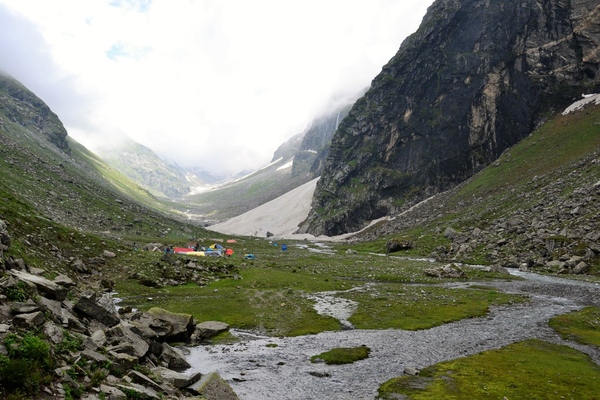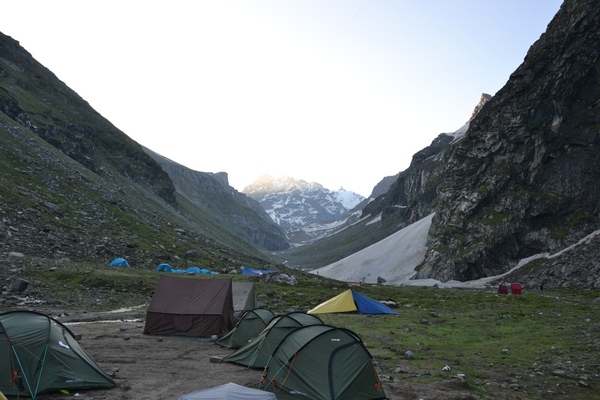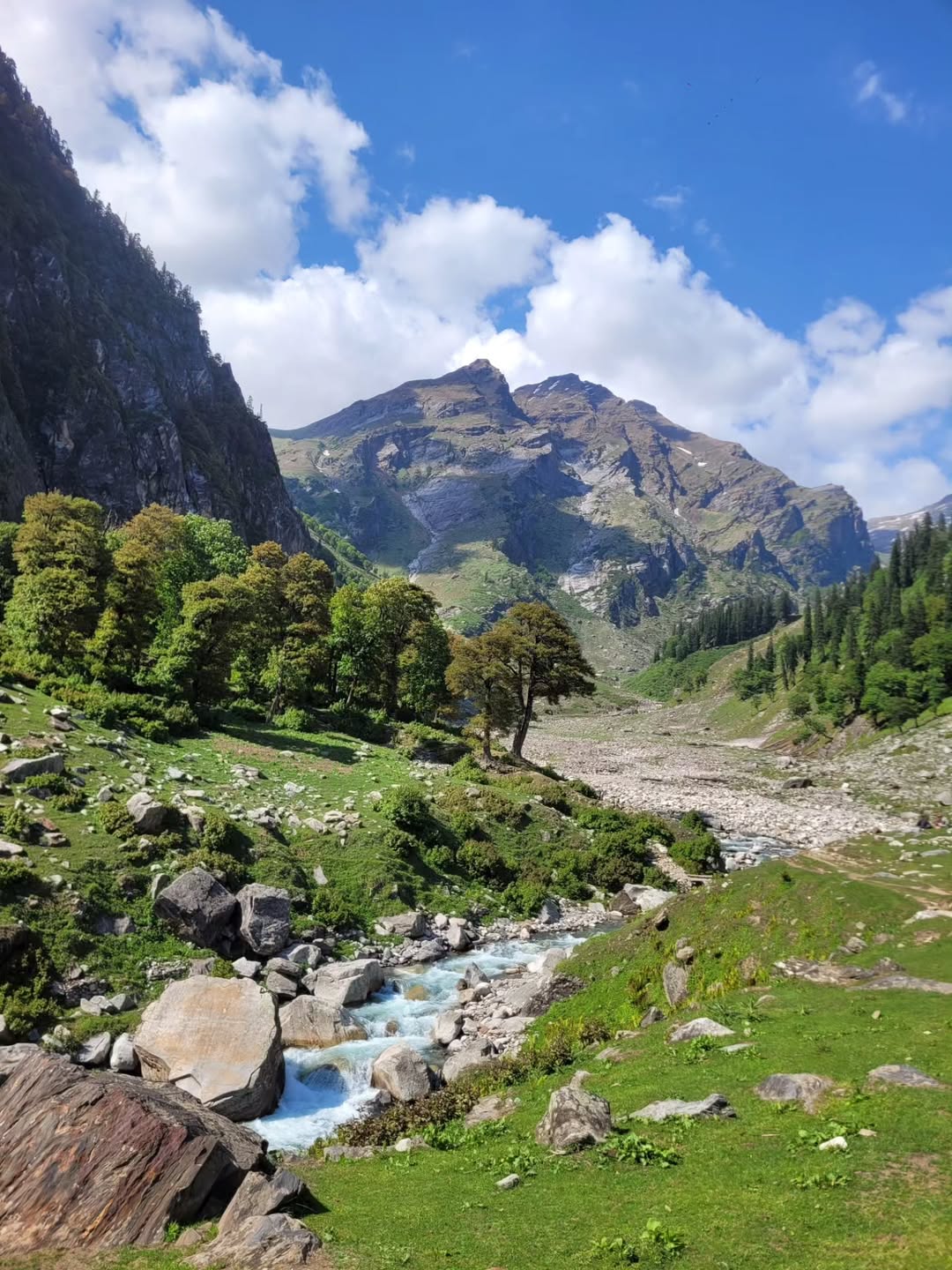Chika
Published on August 23, 2025
If you are planning the Hampta Pass trek, one of the first names you’ll hear is Chika — a beautiful meadow campsite that feels like it was taken straight out of a fairy tale. Located deep in the mountains of Himachal Pradesh, Chika is known for its lush green fields, snow-fed streams, and dramatic waterfalls cascading from towering cliffs.
Chika is not a tourist town. There are no hotels, shops, or restaurants here. Instead, it’s a quiet paradise, accessible only by trekking through narrow forest trails. For adventure lovers, this campsite offers peace, fresh mountain air, and a stunning backdrop to spend your first night under the stars during the Hampta Pass trek.
Where is Chika Located?
Chika lies on the trail leading from Jobra (the roadhead for Hampta Pass) toward Balu ka Ghera. It sits at an altitude of about 10,000 feet (3,050 meters) in the Kullu Valley. The trek from Jobra to Chika is about 2 km to 3 km and takes around 2 hours at a comfortable pace, making it an easy first-day hike even for beginners.
Why is Chika Famous?
-
First Campsite of Hampta Pass Trek – It’s where trekkers spend their first night on the way to Hampta Pass.
-
Waterfalls and Cliffs – The meadow is surrounded by dramatic cliffs and small streams flowing down as waterfalls.
-
Picturesque Setting – The scenery is perfect for photography, with snow-covered peaks in the distance and grazing sheep adding to the charm.
-
Beginner Friendly – The trek to Chika is short and not very steep, making it suitable for those trekking in the Himalayas for the first time.

The Trek to Chika – Step by Step
-
Start at Manali: Trekkers usually begin their journey from Manali, a popular hill station about 16 km from Jobra, the starting point of the trek.
-
Drive to Jobra: A short scenic drive takes you through pine forests and winding roads to Jobra. This is the last point accessible by vehicle.
-
Trek from Jobra to Chika:
-
Distance: About 2 km – 3 km.
-
Time: Around 2 hours.
-
Trail: The path passes through dense forests of pine, maple, and oak, opening into wide green meadows.
-
Difficulty: Easy — suitable for beginners.
-
By the time you reach Chika, you’ll already feel far from the noise of the city, surrounded by the sound of flowing streams and chirping birds.
The Beauty of Chika Campsite
The first thing you’ll notice when you arrive at Chika is how open and peaceful it feels. Unlike the steep slopes and narrow paths you trek through earlier in the day, this meadow spreads out wide and flat. You’ll see:
-
Clear Streams: Fresh water flows directly from melting snow. Trekkers use these streams to refill bottles.
-
Waterfalls from Rocky Cliffs: Multiple small waterfalls cascade down black cliffs that frame the meadow.
-
Green Grazing Land: Shepherds often bring their sheep here during summer, adding to the picturesque charm.
-
Snowy Peaks in the Distance: If you trek in June or July, you’ll see patches of snow along the mountains.
When the sun sets, the entire campsite glows golden, and at night, the sky fills with countless stars. This natural beauty makes Chika one of the most memorable stops on the Hampta Pass trek.
Camping at Chika
Camping at Chika is simple but magical. Trekkers sleep in tents arranged by tour operators or trekking groups. Since there are no permanent structures, you get an authentic wilderness experience.
-
Food: Meals are cooked by trek leaders or guides using portable stoves.
-
Water: Directly sourced from streams — always fresh and cold.
-
Facilities: Basic — there are no toilets or electricity, so portable options are used.
This is where trekkers start bonding, sharing stories by the campfire, and preparing for the next day’s journey.
Weather at Chika
The temperature at Chika depends on the season:
-
Summer (June – July): Daytime 12°C to 15°C, Nighttime 0°C to 5°C.
-
Post-Monsoon (August – September): Daytime 10°C to 12°C, Nighttime -2°C to 3°C.
Even during summer, nights can be very cold, so warm clothing is essential. Occasional rain showers are also common, making the meadow look fresh and even more beautiful.
Best Time to Visit Chika
The trek to Chika is only possible when the Hampta Pass route is open:
-
June to September: The best time to trek. Snow is still visible in early June, while meadows are lush and green in July and August. By September, skies are clear and perfect for photography.
-
October to May: The region is inaccessible due to heavy snow.
Things to Do in Chika
While Chika is primarily a trekking campsite, there’s still plenty to enjoy:
-
Relax and Unwind: Breathe fresh air and listen to the sound of flowing water.
-
Photography: Capture waterfalls, green meadows, and snow-capped mountains.
-
Stargazing: Clear skies at night give you breathtaking views of the Milky Way.
-
Stream Walks: Dip your feet into icy-cold streams for a refreshing experience.

What to Pack for Chika
Since Chika is remote, you’ll need to carry everything you need:
-
Warm Jackets and Thermals – Even summer nights are freezing.
-
Trekking Shoes – Good grip is important on uneven paths.
-
Raincoat/Poncho – Weather changes quickly in the mountains.
-
Water Bottle – You can refill it from streams.
-
Snacks/Energy Bars – For a quick boost during the trek.
-
Torch/Headlamp – No electricity, so you’ll need your own light source.
Nearby Trekking Stops
-
Jobra (Start Point): A forested area where the trek begins.
-
Balu ka Ghera: The next campsite after Chika — a wide valley surrounded by snow.
-
Hampta Pass: The highest point of the trek at around 14,000 feet.
-
Chatru: The final stop where the trek ends before driving back to Manali or heading toward Spiti.
In Conclusion
Chika is not just a campsite — it’s the first step into the world of high-altitude trekking. Its peaceful meadows, crystal-clear streams, and dramatic cliffs create the perfect atmosphere for adventure and relaxation. Whether you’re an experienced trekker or stepping into the Himalayas for the first time, Chika will leave you with memories of nature at its purest.
With no crowds, no hotels, and no noise, Chika reminds you what traveling in the mountains is really about — simplicity, serenity, and stunning beauty.
